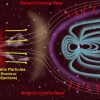Many people claim the
first person to walk on the surface of Mars has already been born. But there are still several things to consider before we send an astronaut to Mars. The reality of prolonged space travel includes various dangers and challenges we have to overcome, not the least of which is
cosmic radiation.
The
Earth’s magnetosphere protects us from the harmful cosmic radiation persistently emitted from the Sun via solar winds. The International Space Station sits within the protection of Earth’s magnetic field so the magnetized plasma particles capable of damaging DNA and causing cancer don’t affect the astronauts on the station. Astronauts in a spacecraft for a prolonged period of time who travel beyond the safety of Earth’s magnetosphere, however, must face the dangers of exposure.
How Do Magnets Protect Against Radiation?
Developments in magnetics might help remove the threat of overexposure as we attempt further exploration in space travel. Researchers are testing two methods of shielding: passive and active shielding. Passive shielding involves using a material capable of absorbing harmful radiation while active shielding repels the radiation using a magnetic field.
Simulating a magnetic field like the one protecting Earth seems like an effective solution. Superconducting magnets are capable of deflecting radiation. A
magnetic radiation shield for a spacecraft was originally thought impossible because the shield would require an expensive, energy-consuming cooling system. With developments in superconducting magnets, however, a more compact superconductor capable of operating without liquid helium cooling is possible. The shield would function like Earth’s by
separating the electrons and protons of harmful particles. The separation would cause a charge and deflect the particles away from the spacecraft.
Researchers and engineers are still working on developing a reliable magnetic radiation shield. Other methods of active shielding using simulated magnetic fields are also underway. One of these projects involves magnetic bubbles. The bubbles would consist of charged particles floating in space, which would be gathered to create a force field capable of deflecting particles. What do you think is the best method for protecting against radiation in space? Please leave a comment!

